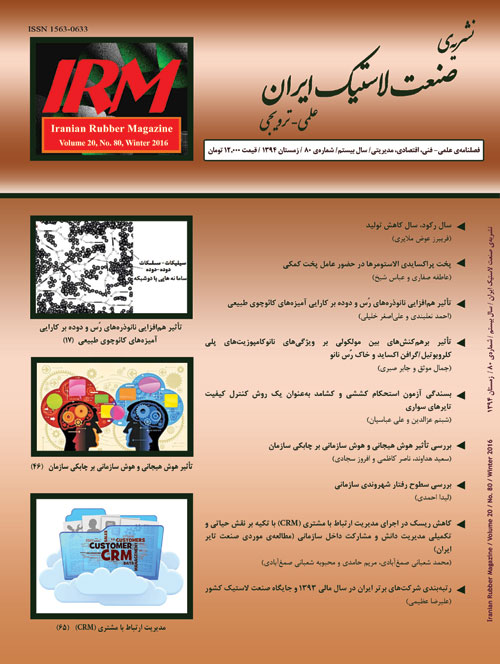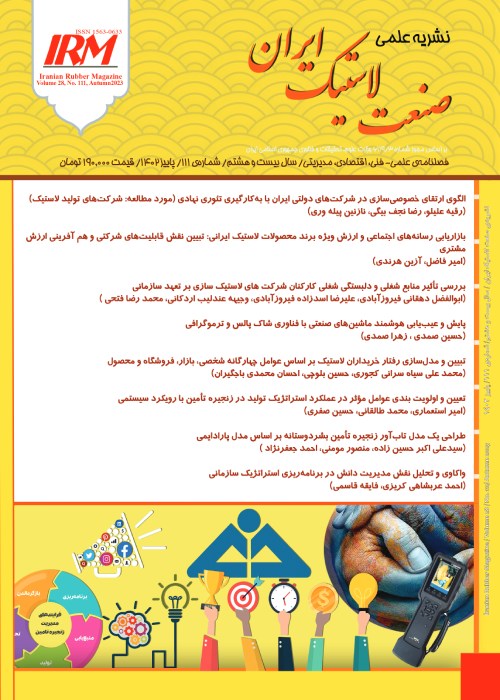فهرست مطالب

نشریه صنعت لاستیک ایران
پیاپی 80 (زمستان 1394)
- تاریخ انتشار: 1395/01/25
- تعداد عناوین: 9
-
- سرمقاله
-
صفحه 3
- علمی فنی
- مدیریت
-
صفحه 55
-
کاهش ریسک در اجرای مدیریت ارتباط با مشتری (CRM) با تکیه بر نقش حیاتی و تکمیلی مدیریت دانش و مشارکت داخل سازمانی / مطالعه موردی صنعت تایر ایرانصفحه 65
- دیدگاه
-
Page 6Peroxide curing due to its widespread application in vulcanization of saturated as well as unsaturated elastomers, is one of the noticeable topics in rubber technology. Although it has poorer mechanical properties in terms of tensile strength and dynamic behavior compared to Sulphur curing but is superior in thermal properties. This can be enhanced using multifunctional vinyl monomers called coagents. They increase both state and rate of cure and give more effective crosslinks with improved mechanical properties. In this paper peroxide curing and coagents are introduced along with their influences on properties of elastomers.Keywords: Vulcanization, Peroxide Curing, Coagent, State of Cure, Mechanical Properties
-
Page 17This paper demonstrates the successful use of nanoclay in a model truck tire formulation and reports the comparison of mechanical and dynamic mechanical properties for a number of natural rubber composites based on carbon black and organoclay. We find that stearic acid modified organoclay seems to dominate reinforcing capabilities as compared with unmodified organoclay. It is also found that the model truck tire compounds can be formulated with 40% less fossil fuel resources without sacrificing various properties. It is also shown that the truck tire formulation made with hybrid fillers offers better rolling resistance performance as compared with a conventional standard compound.Keywords: Nanoclay, Aacid stearic, Carbon black, Natural rubber, Reinforcement
-
Page 30Nano composites of Graphene Oxide and modified nanoclay (Cloisite 15A) were
produced based on 80 phr Chlorobuthyl and 20 phr natural rubber, according to inner liner
recipe. The results show modified nanofillers have remarkable change in dispersion in the
matrix. Subsequently, improved cured composites properties. Exfoliation of Graphen Oxide
and Cloisite 15A was confirmed by XRD and TEM.But in the case of graphite, intercalation
was happened. Finaly, physical and mechanical properties of this composite was studied.Keywords: Chlorobuthyl, Graphite, Graphene Oxide, Nanoclay, Nanocomposite -
Page 36Most tire failures in Saudi Arabia result in severe vehicle crashes. Tire failures, such as tread separation and blowouts, are the most notable events that occur on a daily basis. This paper deals with the elongation and tensile strength of the tire rubber as quality control criteria in evaluation vehicle tires. Specimens from six different tire brands were subjected to laboratory tests to investigate the tensile strength and elongation of the tire rubber. The laboratory results and the statistical field survey data were compared to determine the possibility of using the tensile strength of rubber as a quality control criterion. The thermal oxidative durability of the investigated tires during aging was also estimated through the loss in their strength.Keywords: Vehicle tires, Tensile strength, Aging of tires, SASO standards
-
Page 46This research aimed at investigation of the Effects on organizational and emotional intelligence variables with organizational agility. This research was applied regarding its goals and explanatory regarding the method and was of correlated type. Population of this study includes 450 personnel of Isfahan Rubber Industries. Who were randomly selected with an error level of 0.05 from a restricted population as 127. Data collection instrument is questionnaire which was devised by researchers combining Albrechts organizational intelligence and Gelmans emotional intelligence questionnaires. Data related to agility factors was collected to measure the agility andfinally factors like flexibility, vivacity, responsiveness, and efficiency were noticed for evaluation. The questionnaire reliability was determined through Chronbach's alpha. Its coefficients is 0.91 showing excessive reliability of the questionnaire. Justifiability of the questionnaire was assessed using expertise consensus method. Explanatory statistics indices including average, standard deviation, variance, percentile computation and deduction statistics like Kolmogorov- Smirnov test, Friedman test, structural equations test, adaptive table and Spls and Spss software were used to analyze data. Research results indicate that emotional intelligence with 0.68 co-efficient has effects on organizational intelligence. On the other hand, organizational intelligence with a coefficient equal to 0. has higher effects on organizational agility compared to emotional intelligence with 0.51 co-efficient within Iran national gas Co. regression model showed that 56% of changes related to organizational agility is explained by two variables of emotional and organizational intelligence.Keywords: Emotional intelligence, Organizational intelligence, Organizational agility, Competitiveness
-
Page 55This research aims to study the levels of organizational citizenship behavior in the workers of Shomal- Fara- Sannat Company. This study investigate the alternatives of organizational citizenship behavior (altruism, conscientiousness, civic virtue, sportsmanship, courtesy). Universe statistic is 230 that the example volume was estimated 104 numbers based on Morgan table. The data measured based on Organ and Konosky questionnaire (1996) and reliability was measured based on Kokran formula (0.894). In order to analyzing data, used from one sample t test and correlation Pearson and one way variance analyze. The findings of the study showed that all of the organizational citizenship behavior alternatives means in workers was higher of medium, except of sportsmanship. Also there was significantly and positively associated in organizational citizenship behavior except sportsmanship.Keywords: Organizational citizenship behavior, Altruism, Civic virtue, Sportsmanship
-
Page 65There are different approaches in the science of management which their theoretical goal is increasing efficiency and profitability. Implementing those approaches in many companies would not have desirable results even with a huge investment. Customer Relationship Management is one of those approaches, which its goals are very interesting because of increasing in profitability and customer satisfaction, but there are some researchers reports that show they are failed in accomplishment. Customer RelationshipManagement is composed of some components like technology, customer knowledge management, organizations culture, and mutual relationship between organization and customer. The author believes that paying too much attention to the technology is one reason of increasing risk in the implementation and the goal of article is risk reduction in the implementation of CRM. In fact, the interaction between executive elements of CRM and the culture of the organization will increase the probability of success. This paper aims to address the implementation of CRM, and to propose the hypotheses based on four parameters of technology infrastructures of CRM, organizational collaboration, knowledge management, and executive CRM risk. The tire industry in Iran has considered as statistical population and data sampling has been done and evaluated with Cronbach's alpha. Data analysis was performed using SPSS and determining the correlation. Correlations between main presented parameters shows that knowledge management and internal organizational collaboration are in line with reducing risk and increasing success in the implementation of CRM.Keywords: Customer Relationship Management, Knowledge management, Organizational collaboration, Information Technology, Marketing


